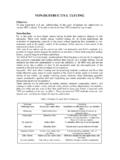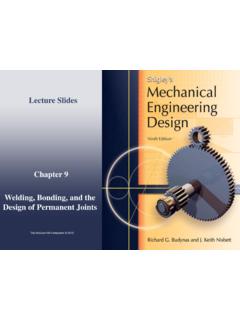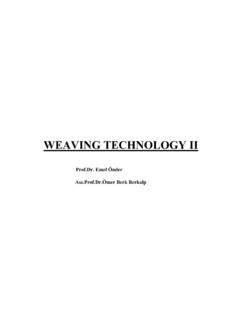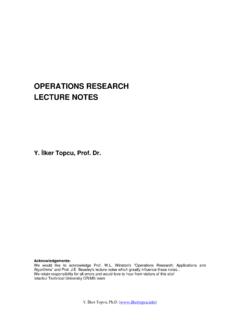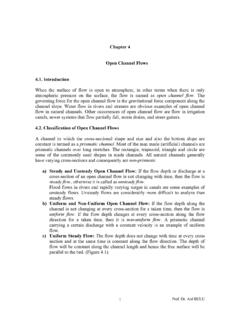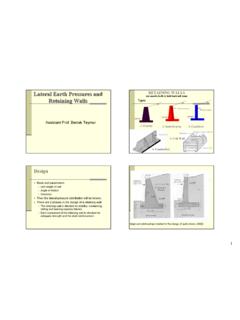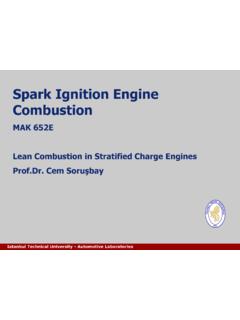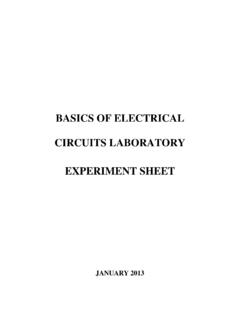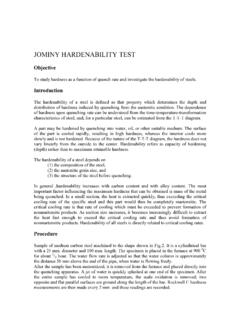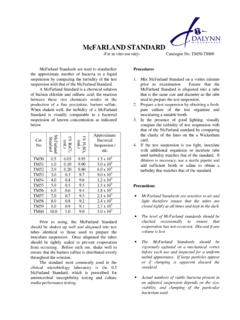Transcription of IMPACT TESTING - İTÜ
1 IMPACT TESTING Objective To conduct Charpy V-notch IMPACT test and determine the ductile-brittle transition temperature of steels. Equipment Coolants Standard Charpy V-Notched Test specimens IMPACT tester Furnace Introduction Notched-bar IMPACT test of metals provides information on failure mode under high velocity loading conditions leading sudden fracture where a sharp stress raiser (notch) is present. The energy absorbed at fracture is generally related to the area under the stress-strain curve which is termed as toughness in some references. Brittle materials have a small area under the stress-strain curve (due to its limited toughness) and as a result, little energy is absorbed during IMPACT failure.
2 As plastic deformation capability of the materials (ductility) increases, the area under the curve also increases and absorbed energy and respectively toughness increase. Similar characteristics can be seen on the fracture surfaces of broken specimens. The fracture surfaces for low energy IMPACT failures, indicating brittle behavior, are relatively smooth and have crystalline appearance in the metals. On the contrary, those for high energy fractures have regions of shear where the fracture surface is inclined about 45 to the tensile stress, and have rougher and more highly deformed appearance, called fibrous fracture.
3 Although two standardized tests , the Charpy and Izod, were designed and used extensively to measure the IMPACT energy, Charpy v-notched IMPACT tests are more common in practice. The apparatus for performing IMPACT tests is illustrated schematically in Figure-I. The load is applied as an IMPACT blow from a weighted pendulum hammer that is released from a position at a fixed height specimen is positioned at the base and with the release of pendulum, which has a knife edge, strikes and fractures the specimen at the notch. The pendulum continues its swing, rising a maximum height h' which should be lower than hnaturally.
4 The energy absorbed at fracture Ecan be obtained by simply calculating the difference in potential energy of the pendulum before and after the test such as, E= (h-h ')where mis the mass of pendulum and gis the gravitational acceleration. The geometry of 55mm long, standard Charpy test specimen is given in Figure-2. If the dimensions of specimens are maintained as indicated in standards, notched-bar IMPACT test results are affected by the lattice type of materials, TESTING temperature, thermo-mechanical history, chemical composition of materials, degree of strain hardening, etc. Figure-I: Apparatus for IMPACT TESTING of materials.
5 Figure-2: Specimen and loading configuration for Charpy V-notched IMPACT test. Body centered cubic (bcc) metals, particularly steels, often exhibit a decrease in IMPACT energy as the temperature is lowered. The temperature at which a sharp decrease in IMPACT energy occurs is called the ductile-brittle transition temperature (DBTT) as shown in Figure-3 schematically. This transition temperature is generally chosen as a lower limit for the application of such metals. Some steels may show transition characteristics in their failure mode from ductile to brittle gradually as temperature is decreased, which is given in Figure-4 schematically.
6 In this case different approaches may be used in determining transition temperature but the average energy concept is the most popular one. Determination of transition temperature can also be done by examining the fracture surfaces of specimens tested at different temperatures. For example the temperature, at which the fracture surface consists 50 percent cleavage (crystalline) and 50 percent ductile (fibrous) types of fracture, is called fracture appearance transition temperature (FATT). Another common criterion is to determine the transition temperature on the basis of an arbitrary energy absorbed.
7 For example 20J transition temperature is an accepted criterion for low-strength ship : Typical ductile-brittle transition curve for annealed low carbon steel. Figure-4: Various criteria of transition temperature obtained from Charpy tests . Procedure Note: Test one material with two specimens for each temperature, 1. Check the zero calibration of the IMPACT tester. 2. First, test a specimen at room temperature. 3. Based on the room temperature result, decide whether to concentrate on higher or lower temperature. 4. Test specimens over a selected range of temperatures, attempting to establish a fully ductile test, a fully (or nearly) brittle test, and as many temperatures in between as possible.
8 5, Note fracture energy and estimate the % brittleness from the appearances of fracture surfaces of the specimens. Lab Report Requirements 1. Results Display the test data in a Table. Plot IMPACT energy versus temperature and % brittleness versus temperature. Find DBTT of the steel that you tested. 2. Discussion (the questions will be answered in the lab report) 1. Give the estimated values of DBTT for your steel. Suggest 2 ways in which DBTT can be lowered. 2. What are the 3 basic factors which contribute to brittle fracture of steels? Do all 3 have to be present for brittle fracture to occur? 3. Explain how a triaxial stress state can arise at the root of a notch.
9 Would this occur in thick or thin material? Thus, when does a biaxial stress state occur? 4. What are the main uses of the Charpy test? the ASTM and TS specifications for the two IMPACT tests with titles. 6. Explain the relation between fracture toughness (KIC) ofsteels and IMPACT energy. 7. Explain the effect of carbon content on transition behavior of plain carbon steels in annealed condition. 8. Explain the effect of manganese on DBTT of steels. References 1. Metals Handbook, 9th ed., Mechanical TESTING , Vol. 8, 1990. 2. G. Dieter, Mechanical Metallurgy, SI ed., Mc Graw Hill, 1986. 3. N. Dowling, Mechanical Behavior of Materials, Prentice Hall, 1993.
10 4. ASTM and TS Standards. 5. ASM Metals Handbook, 9th ed. Vol. 12. FATIGUE TESTING Objective To demonstrate how fatigue tests are conducted and how to interpret results. Introduction Fatigue failure accounts for the majority of mechanical failure of metallic materials subjected to cyclic loads. Fatigue failures result from repeated applications of stress which is usually well below the static yield stress. Fatigue cycles are often completely reversed state of stress, tension and compression in a rotating beam but can also be tension-tension. In all cases the number of cycles to produce failure increases with the lowering of the stress leve1.
